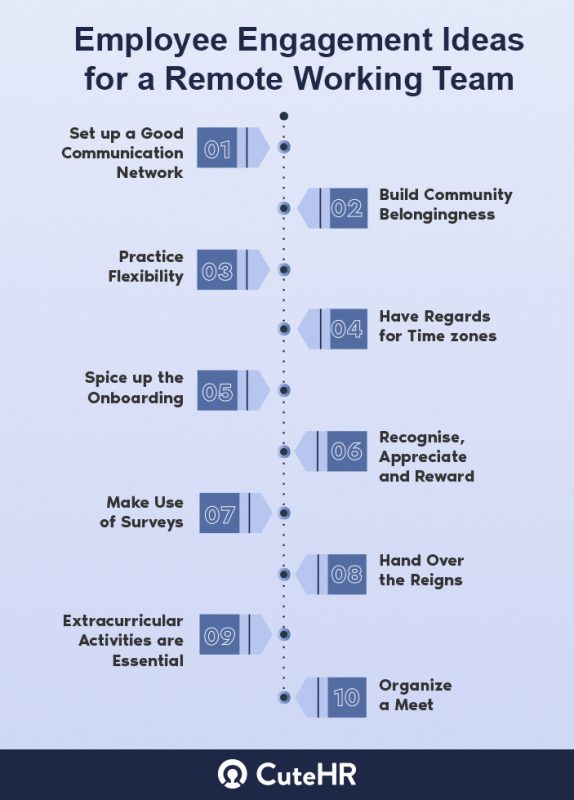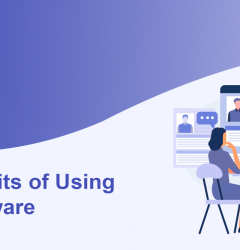09 Jul

Work from home or telecommuting has brought significant changes in the industrial and corporate domains. The HR managers and professionals worldwide experiment, discover and employ various work from home strategies to efficate their operations remotely. But employee engagement ideas for the remote working team still remains the most sought after concern.
There are various strategies and designs that managers can follow for successful employee onboarding and engagement. In the end, an altogether versatile and different approach is needed for engaging telecommuters.
The major question remains – how to develop employee engagement ideas for remote working team? An exhaustive strategy is discussed below.
Table of Contents
Why Focus on Engaging Employees?
To stay ahead in the war for talent, hiring and retention are crucial. The fast pace at which current businesses and corporate sectors are evolving has led managers, professionals, and institutions to look for enhanced methods of operation. Telecommuting emerges as a developing trend. Nonetheless, there are drastic changes that telecommuting demands. But employee retention and talent acquisition remain a top priority in both the business operating models. Here employee engagement emerges as a contributive factor. An exhaustive, well-framed employee engagement plan can affect various different domains and can be conducive enough to bring the desired results.
Gallup identifies engaged employees as “ Those who are involved in, enthusiastic about and committed to their work and workplace”.
Employee engagement (both in house and remotely) is positively related to and directly proportional to a company’s success. It is a direct depiction of the level of employee commitment and investment.
Factors Influencing Employee Engagement
- Productivity – Engaged employees show enhanced productivity levels and help muster more profit.
- Absenteeism – Happy employees look forward to work and do not escape by taking excessive leaves.
- Improved Service and Results – More the number of dedicated employees, much productively enhanced and superior are their results.
- Increased Retention and Low Turnover Rate – Satisfied employees tend to stick with the organization longer, reducing the turnover rate. This is largely beneficial as the company can focus on essential services instead of spending money on frequent recruitment, training, and onboarding programs.
In essence, employee engagement is needed to make the office work more interesting, challenging, appealing, and less stressful alongside promoting job satisfaction. This improves motivation at workplace.
The urgency of employee engagement develops manifolds in the case of Remote working employees as –
- Lack of social life tends to make work from homeless engaging
- Telecommuters may feel less motivated to work and may develop a laid-back attitude towards work.
- In the absence of a supervisor or monitoring activities, work from home employees may not be able to discipline themselves.
- A work-life balance could cease to exist when working from home.
Alongside there are tremendous drawbacks that can hamper work in the shortage of employee engagement ideas for work from home employees. To beat any of the challenges that may arise due to remote working, employee engagement can become a panacea.
“Employee engagement is the art and science of engaging people in authentic and recognized connections to strategy, roles, performance, organization, community, relationship, customers, development, energy, and happiness to leverage, sustain, and transform work into results.”
David Zinger, employee engagement speaker, educator, and community builder
Employee Engagement Ideas for A Remote Working Team

Managers can take a hint from the top 10 employee engagement ideas for remote workers given below and mold them to suit their organizational needs.
1. Set up a Good Communication Network



Establishing good communication is central to a work from home scenario. Why?
- Good communication facilitates a clear and smooth flow of information from tier to tier.
- Doubts, queries, remarks, and feedback can be put across.
- The presence of a social circle, which is otherwise absent in remote working can successfully be felt.
- Managers and the company can convey a feeling of belongingness or imbue company ethics in their remote workers through regular communication.
- A remote employee would also feel connected and participate in the social atmosphere of the office by communication.
Considering the advantages enlisted above, there are various methods of communication that an organization can adopt to engage its work from home employees as enlisted below –
Video calls, conferences, and chat boxes
There is nothing more personal than a video call with the entire team. Chatbox, calls, and video conferences are any day, a better option than a monotonous phone call or text. To increase employee engagement, regular video calling definitely increases communication, builds trust, and brings more transparency.
Moreover, employees must be encouraged to ask more questions and feel welcomed. A feeling of belongingness and warmth is pivotal to develop seamless communication.
The usage of proper remote tools for the same is important as well. The growing usage of chat boxes is gaining popularity. Slack, Zoom, GoToMeeting, Proofhub, Google Hangouts, etc are reliable tools for video calling



The need to increase communication in a remote working sphere is even more urgent, considering that an Interact survey says that
More than 37% of managers and business leaders are uneasy delivering feedback and criticism of their employee’s performance.
Such an attitude and inhibitions or fear of bad reaction will hamper growth and any possibilities of improvement. Among all the employee engagement ideas for remote working, video calling or an on-camera presence is the most reliable.
2. Build Community Belongingness



Any remote worker shouldn’t be left to work in isolation. Despite regular communication, there can be moments when an employee can feel left out. This can be due to the absence of office culture in a work from home setting.
Managers must keep their mental well-being and the social needs of their remote workers at the apex.
Following are the practical measures to inculcate a sense of community in work from home employees :
- Managers ought to provide for a platform or space where employees can exchange all significant (work or nonwork-related) updates. Here the manager needs to work as mentors.
- There must be equal amounts of formal and informal talk between the workforce. The same approach must be followed by remote workers.
- As a part of employee engagement ideas for work home employees, all employee information like birthdays, anniversaries along with significant milestones, team achievements must be regularly notified and celebrated.
3. Practice Flexibility



The key feature of work from home is flexibility – flexibility to work from anywhere, flexibility to work any time of the day/night, flexibility to work in their preferred environment. This is the reason why
40% of the workforce consider it to be the most advantageous feature of working remotely,
says Buffer.
Therefore, managers must make use of this flexibility and not burden their remote working staff with unnecessary deadlines. More importantly, the focus should be to erect and establish a work culture that is powered by technology, backed by flexibility, and enables modernization in working remotely.
Organizations have to realize that flexibility is the marrow of work from home culture. Practicing flexibility as one an employee engagement ideas for work from home has the following benefits –
- It allows remote workers to understand and inculcate a feeling of responsibility.
- Gives the freedom to work as per their schedule, time and productivity levels
- It allows managers to focus on more important tasks.
4. Have Regards for Time zones
The biggest fringe benefit of remote working is the ability to have people work for you from anywhere around the world. This benefit can be utilized best only when the managers have respect for their employees’ time. A standard management strategy for engagement and involvement is to give remote workers enough freedom to pick their schedules. Forced working hours will produce nothing but unfocused and stressed out employees. Consequently, they will be less engaged.
Abstain from an “always-on” work environment because it is counterproductive and unethical. Managers should definitely have regards for holidays, festivals and weekends. Bothering remote workers at odd hours is a clear disrespect for their time and privacy.
Remote working employees should be imparted the optimum time and necessary freedom so that they are self-driven, motivated, and inclined to work. Nagging or breathing down their neck will be interruptive.
5. Spice up the Onboarding



In the case of hiring employees virtually, there is a need to carefully assess them. This assessment should not just be limited to their work-related capabilities but should largely focus on their ability to work remotely. This makes remote hiring a bit tricky.
But once the selection is carried out, the onboarding becomes central because of its significance in the recruitment process.
The seriousness of onboarding escalates when remote employees are in question. They must be properly introduced to various tools, applications, managers, guidelines, and rules so as to avoid any confusion. With the help of a mentor or a guide, daily check-ins, and guidance to office work and process should be facilitated. To further ease the onboarding process, a buddy or a cultural coach can function as an informal guide to the new employee. They can entertain informal questions and requests.
Onboarding remote workers should largely be the HR department’s responsibility. But the in-house workforce must contribute towards it too. They can do this by establishing communication with remote co-workers, introducing and involving them in office chats, solving their queries, and being a responsible co-worker.
6. Recognize, Appreciate and Reward
As per a survey conducted by Quantum workplace,
62% of the employees found remote working/telecommuting to boost and amplify their engagement.
The facility of remote working is a boon to both – company and its employees. Hence, despite extracting maximum work from telecommuters, they should be given due rewards and attention too.
The essence of a healthy work environment is to celebrate your people, their achievements (big or small), showcase them and appreciate the work they do. For instance, a simple way to do is by recognizing stellar work by a remote employee, which otherwise would have gone unnoticed. This further strengthens trust and respect for remote employees. Nonetheless, serves as an example of good company ethics.
Recognition, rewards, combined with a sense of belonging renders much useful for the company in the long run.
7. Make Use of Surveys
Surveys are a good way to create a portal for honest feedback and opinion. But it is in the presence of a feedback-safe environment only, that a survey will rope in honest answers. As a method to determine employee engagement ideas for work from home, pulse surveys can be used from time to time. Google forms are a widely used tool for this purpose.
However, it is pointless to design elaborate and boring surveys. With a particular objective in mind, can a survey be marked as helpful?
Additionally, companies can personalize surveys and manipulate their appeal accordingly. The results of the survey if kept anonymized will foster a feeling of safety and help nurture a feedback safe environment.
- A survey is a strikingly useful weapon to analyze employee engagement and satisfaction levels.
- Surveys can be used to know about employee preferences and favorites. This information can be utilized to make changes in the working structure or improve engagement.
- The survey must be relevant and include specially curated questions for remotely working staff.
- For managers and employees, a survey is the best means to stay transparent and expound on the organization’s state of engagement.



8. Hand Over the Reigns
Firstly, managers must understand that remote workers can make use of their flexible schedules and the less distrustful settings to handle essential projects and responsibilities. Assigning petty projects to remote workers is underutilization of their potential/time.
A study at Stanford proves that
Employee attrition fell by 50% among telecommuters. Additionally, the work from home population was more dedicated, punctual, and inclined to work a true shift.
Moreover, the distribution of significant and important work for remote employees makes them feel valued and purposeful.
Secondly, remote working staff must not be micromanaged. A healthy and popular practice in such a scenario is to assign work/projects, give a detailed briefing, convey deadlines, and communicate to clarify doubts (when/if needed). Here the bothersome step of tracking daily progress is eliminated. There are tools for project management like CuteHR, Trello, Asana, or Basecamp that are highly useful. A manager ought to trust his remote worker with the work allotted and respect his schedule so that there is harmonical work-life balance.
The success of remote working comes from the optimal trust on the managerial forefront and the flawless execution on the remote employee end. Such a skillful concoction is one of the best employee engagement ideas for work from home employees.
9. Extracurricular Activities are Essential



The major downside of working remotely is the feeling of isolation or loneliness.
As per a Buffer report,
19% of the remote employees find loneliness as their biggest obstacle.
To combat this, the presence of a strong work culture is a must. As discussed above, talks and discussions can be held through integrated calling and chatbox applications. But apart from work, fun activities like virtual game nights, (online chess tournaments, card games, board games, etc), non-work related video conferencing, fun challenges, and celebrations are employee engagement ideas for work from home.
These activities will not only help in-house staff and management to get to know the employees better but can also be utilized strategically to assess the mental well-being of the remote working population. Among all the employee engagement ideas for work from home, managers stick to extracurricular activities as it definitely intrigues and involves employees.
10. Organize a Meet
To make sure that remote workers get the necessary exposure to the organization, there should be planned an official meet up of remote employees. This will prove beneficial so as to impart knowledge of organizational attitude, ethics, and will obviously function to improve and strengthen office relationships.
The core agenda to organize an official meet up for remote employees is to acquaint them with the institution they work for and the people they report to or collaborate with.
As a matter of fact, special workshops can be arranged, as a part of skill enhancement. Remote workers can make use of such opportunities to socialize and gain necessary tutelage.
Conclusion
As can be understood from the above discussion, telecommuters or your work from home population is not different from in-house workers. It requires the right amount of attention, flexibility, benefits, and communication to increase their engagement.
This blueprint of employee engagement ideas for work from home employees greatly aids to engage remote workers. This engagement is necessary as it comes with its own perks. Therefore, every organization must personalize to curate their own agenda and plan of action for enhanced management. Giving attention to your remote workers and adding a dash of fun engagement activities can prove to be a hit.



Remote Team Engagement FAQ’s
Let us understand some common queries related to employee engagement for remote team
Why Remote Employee Engagement Important?
How to increase employee engagement?
What are some employee engagement ideas?
Astute Human Resource Professional with 13 years of experience and a strong focus on details.Sound exposure to Talent Management, Performance Appraisal, Employee Engagement, Rewards, and Recognition & Research
You must also read
- Reply Your comment is awaiting moderation.
izmir travesti
April 14, 2025izmir travesti
izmir travesti
- Reply Your comment is awaiting moderation.
child porn
April 13, 2025Top 10 Employee Engagement Ideas for Remote Working Team
- Reply Your comment is awaiting moderation.
child porn
April 13, 2025Top 10 Employee Engagement Ideas for Remote Working Team
- Reply Your comment is awaiting moderation.
child porn
April 2, 2025Top 10 Employee Engagement Ideas for Remote Working Team
- Reply Your comment is awaiting moderation.
child porn
March 31, 2025Top 10 Employee Engagement Ideas for Remote Working Team
- Reply Your comment is awaiting moderation.
child porn
March 30, 2025Top 10 Employee Engagement Ideas for Remote Working Team
- Reply Your comment is awaiting moderation.
child porn
March 30, 2025Top 10 Employee Engagement Ideas for Remote Working Team
- Reply Your comment is awaiting moderation.
child porn
March 23, 2025Top 10 Employee Engagement Ideas for Remote Working Team
https://astargogroup.cl/2022/06/24/help-me-create-a-thesis-statement/
- Reply Your comment is awaiting moderation.
child porn
March 20, 2025Top 10 Employee Engagement Ideas for Remote Working Team
http://www.pinkdischarge.net/clear-discharge-before-period-causes-occurrence-consequences/
- Reply Your comment is awaiting moderation.
child porn
March 18, 2025Top 10 Employee Engagement Ideas for Remote Working Team
- Reply Your comment is awaiting moderation.
child porn
March 14, 2025Top 10 Employee Engagement Ideas for Remote Working Team
- Reply Your comment is awaiting moderation.
child porn
March 12, 2025Top 10 Employee Engagement Ideas for Remote Working Team
- Reply Your comment is awaiting moderation.
child porn
March 10, 2025Top 10 Employee Engagement Ideas for Remote Working Team
- Reply Your comment is awaiting moderation.
child porn
March 9, 2025Top 10 Employee Engagement Ideas for Remote Working Team
- Reply Your comment is awaiting moderation.
child porn
March 5, 2025Top 10 Employee Engagement Ideas for Remote Working Team
- Reply Your comment is awaiting moderation.
child porn
March 4, 2025Top 10 Employee Engagement Ideas for Remote Working Team
https://pwcc.upenn.edu/penn-wharton-china-center-homepage-video-test/
- Reply Your comment is awaiting moderation.
child porn
March 3, 2025Top 10 Employee Engagement Ideas for Remote Working Team
- Reply Your comment is awaiting moderation.
child porn
March 1, 2025Top 10 Employee Engagement Ideas for Remote Working Team
https://insanonline.net/2019/07/17/مواصفات-هاتف-هواوي-الجديد/
- Reply Your comment is awaiting moderation.
child porn
February 28, 2025Top 10 Employee Engagement Ideas for Remote Working Team
- Reply Your comment is awaiting moderation.
child porn
February 27, 2025Top 10 Employee Engagement Ideas for Remote Working Team
- Reply Your comment is awaiting moderation.
child porn
February 23, 2025Top 10 Employee Engagement Ideas for Remote Working Team
- Reply Your comment is awaiting moderation.
child porn
February 21, 2025Top 10 Employee Engagement Ideas for Remote Working Team
https://dagensmedicin.dk/superviseren-jeg-skal-pleje-mit-netvark-pa-asco/
- Reply Your comment is awaiting moderation.
child porn
February 18, 2025Top 10 Employee Engagement Ideas for Remote Working Team
- Reply Your comment is awaiting moderation.
child porn
February 15, 2025Top 10 Employee Engagement Ideas for Remote Working Team
- Reply Your comment is awaiting moderation.
child porn
February 2, 2025Top 10 Employee Engagement Ideas for Remote Working Team
https://patriotswire.usatoday.com/lists/twitter-reacts-patriots-defensive-destruction-colts/
- Reply Your comment is awaiting moderation.
child porn
January 18, 2025Top 10 Employee Engagement Ideas for Remote Working Team
https://merlinsmusings.com/2019/11/26/anime-review-the-helpful-fox-senko-san/
- Reply Your comment is awaiting moderation.
child porn
January 13, 2025Top 10 Employee Engagement Ideas for Remote Working Team
https://www.theday.com/sports/20220719/stanton-hits-two-run-blast-named-mvp-as-al-stars-beat-nl-3-2/
- Reply Your comment is awaiting moderation.
child porn
January 7, 2025Top 10 Employee Engagement Ideas for Remote Working Team
- Reply Your comment is awaiting moderation.
child porn
January 1, 2025Top 10 Employee Engagement Ideas for Remote Working Team
http://www.shoulder2wrist.co.uk/surgery-for-your-wrist-fracture/
- Reply Your comment is awaiting moderation.
child porn
December 30, 2024Top 10 Employee Engagement Ideas for Remote Working Team
- Reply Your comment is awaiting moderation.
child porn
December 29, 2024Top 10 Employee Engagement Ideas for Remote Working Team
- Reply Your comment is awaiting moderation.
child porn
December 25, 2024Top 10 Employee Engagement Ideas for Remote Working Team
- Reply Your comment is awaiting moderation.
child porn
December 21, 2024Top 10 Employee Engagement Ideas for Remote Working Team
- Reply Your comment is awaiting moderation.
child porn
December 20, 2024Top 10 Employee Engagement Ideas for Remote Working Team
https://blogs.uml.edu/m2d2/2020/08/26/meet-a-200k-challenge-finalist-oriel-research-therapeutics/
- Reply Your comment is awaiting moderation.
child porn
December 17, 2024Top 10 Employee Engagement Ideas for Remote Working Team
- Reply Your comment is awaiting moderation.
child porn
December 4, 2024Top 10 Employee Engagement Ideas for Remote Working Team
- Reply Your comment is awaiting moderation.
child porn
November 28, 2024Top 10 Employee Engagement Ideas for Remote Working Team
- Reply Your comment is awaiting moderation.
child porn
November 18, 2024Top 10 Employee Engagement Ideas for Remote Working Team
- Reply Your comment is awaiting moderation.
child porn
November 17, 2024Top 10 Employee Engagement Ideas for Remote Working Team
- Reply Your comment is awaiting moderation.
child porn
November 16, 2024Top 10 Employee Engagement Ideas for Remote Working Team
https://eaters.es/2019/11/20/unusual-dinners-de-hendricks-gin/
- Reply Your comment is awaiting moderation.
child porn
November 14, 2024Top 10 Employee Engagement Ideas for Remote Working Team
- Reply Your comment is awaiting moderation.
child porn
November 5, 2024Top 10 Employee Engagement Ideas for Remote Working Team
- Reply Your comment is awaiting moderation.
child porn
November 4, 2024Top 10 Employee Engagement Ideas for Remote Working Team
https://www.tommyprint.com/2019/11/18/whole-grain-bread-for-breakfast/
- Reply Your comment is awaiting moderation.
kütahya günlük apart daire
October 26, 2024kütahya günlük apart daire
kütahya günlük apart daire
- Reply Your comment is awaiting moderation.
istanbul boşanma avukatı
October 22, 2024istanbul boşanma avukatı
istanbul boşanma avukatı
- Reply Your comment is awaiting moderation.
child porn
October 22, 2024Top 10 Employee Engagement Ideas for Remote Working Team
https://www.tetedechat.com/blog/index.php/taiwan-best-trip-jour-4/
- Reply Your comment is awaiting moderation.
gaziantep saat tamiri
October 21, 2024gaziantep saat tamiri
gaziantep saat tamiri
- Reply Your comment is awaiting moderation.
child porn
October 20, 2024Top 10 Employee Engagement Ideas for Remote Working Team
https://cupofjo.com/2020/09/24/how-to-help-after-rbgs-death/
- Reply Your comment is awaiting moderation.
child porn
October 17, 2024Top 10 Employee Engagement Ideas for Remote Working Team
- Reply Your comment is awaiting moderation.
child porn
October 13, 2024Top 10 Employee Engagement Ideas for Remote Working Team
- Reply Your comment is awaiting moderation.
porn
October 11, 2024Top 10 Employee Engagement Ideas for Remote Working Team
https://www.withloveleena.com/5-tips-for-choosing-your-hijabi-graduation-outfit/
- Reply Your comment is awaiting moderation.
child porn
October 5, 2024Top 10 Employee Engagement Ideas for Remote Working Team
- Reply Your comment is awaiting moderation.
child porn
October 3, 2024Top 10 Employee Engagement Ideas for Remote Working Team
- Reply Your comment is awaiting moderation.
child porn
September 24, 2024Top 10 Employee Engagement Ideas for Remote Working Team
- Reply Your comment is awaiting moderation.
child porn
September 11, 2024Top 10 Employee Engagement Ideas for Remote Working Team
- Reply Your comment is awaiting moderation.
child porn
September 8, 2024Top 10 Employee Engagement Ideas for Remote Working Team
- Reply Your comment is awaiting moderation.
child porn
August 30, 2024Top 10 Employee Engagement Ideas for Remote Working Team
https://www.globalatlanta.com/atlanta-mayor-speaks-in-geneva-on-ending-racial-bias/
- Reply Your comment is awaiting moderation.
child porn
August 29, 2024Top 10 Employee Engagement Ideas for Remote Working Team
https://rohrreinigung-moers-klempner.de/rohrreinigung/moers-scherpenberg/
- Reply Your comment is awaiting moderation.
bursa travesti tumblr
August 25, 2024bursa travesti tumblr
bursa travesti tumblr
- Reply Your comment is awaiting moderation.
child porn
August 22, 2024Top 10 Employee Engagement Ideas for Remote Working Team
- Reply Your comment is awaiting moderation.
bursa travesti
August 7, 2024bursa travesti
bursa travesti
- Reply Your comment is awaiting moderation.
oruspu cocugu dolandırıcı
August 4, 2024oruspu cocugu dolandırıcı
oruspu cocugu dolandırıcı
- Reply Your comment is awaiting moderation.
child porn
June 29, 2024Top 10 Employee Engagement Ideas for Remote Working Team
- Reply Your comment is awaiting moderation.
child porn
June 29, 2024Top 10 Employee Engagement Ideas for Remote Working Team
http://batukamma.com/insights-into-speedy-products-in-writing-service/
- Reply Your comment is awaiting moderation.
child porn
June 26, 2024Top 10 Employee Engagement Ideas for Remote Working Team
- Reply Your comment is awaiting moderation.
child porn
June 22, 2024Top 10 Employee Engagement Ideas for Remote Working Team
- Reply Your comment is awaiting moderation.
child porn
June 15, 2024Top 10 Employee Engagement Ideas for Remote Working Team
- Reply Your comment is awaiting moderation.
child porn
June 14, 2024Top 10 Employee Engagement Ideas for Remote Working Team
- Reply Your comment is awaiting moderation.
child porn
June 7, 2024Top 10 Employee Engagement Ideas for Remote Working Team
- Reply Your comment is awaiting moderation.
grandpashabet
May 17, 2024Top 10 Employee Engagement Ideas for Remote Working Team
https://gosocialdetroit.com/la-na-ngbnks/953e97-how-did-lisa-blount-die
- Reply Your comment is awaiting moderation.
porn
May 4, 2024Top 10 Employee Engagement Ideas for Remote Working Team
- Reply Your comment is awaiting moderation.
child porn
April 18, 2024Top 10 Employee Engagement Ideas for Remote Working Team
- Reply Your comment is awaiting moderation.
child porn
March 29, 2024Top 10 Employee Engagement Ideas for Remote Working Team
https://www.sydneycatholic.org/our-archbishop/archbishops-homilies/
- Reply Your comment is awaiting moderation.
Bu site sitemap tarafından oluşturulmustur
March 23, 2024Top 10 Employee Engagement Ideas for Remote Working Team
- Reply Your comment is awaiting moderation.
porn
March 18, 2024Top 10 Employee Engagement Ideas for Remote Working Team












Jyoti Kapoor